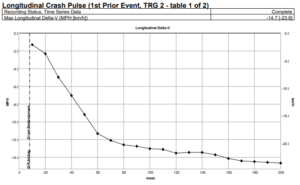Crash Data Preservation
Garrett Discovery’s experts have provided testimony in over 1,000 trials and hearings across all 50 U.S. states. We specialize in extracting data from vehicles and delivering court-ready reports. Each Crash Report includes an additional resource outlining other potential data sources for the vehicle, such as third-party companies that may hold relevant information, along with the contact details for their subpoena compliance departments, including email, address, and phone number.
Crash Data Report - Data Types
- Pre-Crash Speed
- Braking
- Seat Belt Usage
- Slide Door Sensor
- Airbag ECU Sensor
- Roll Angle
- Crash Type
- Shift Position
- Engine RPM
- Deployment Data
- Steering
- Throttle Position
- Delta-V
- TRG Count
- DTCs Present at Time of Event
- Rollover Crash Pulse
- Buckle Switch
- Occupancy Status
- Accelerator Rate
*CDR may verify absence of crash event data*
Avoid Spoliation Claims
Prove your case through data
Reduce Risk of filing lawsuits not supported by the data
Gain Valuable insights into the day of the crash
Cross reference mobile data (Text, GPS)

Roll Rate
A measure of the rate at which the vehicle is changing its degree of roll. It is important to note that this measurement is a rate. Positive/negative convention varies across vehicles and is defined in each report.

Yaw Rate
A measure of the rate at which the vehicle is changing its degree of rotation. It is important to note that this measurement is a rate.

Longitudinal Acceleration
A measure of how hard the vehicle is accelerating or decelerating. Longitudinal acceleration can also be impact induced.

Lateral Acceleration
A measure of how hard the vehicle is cornering. Lateral acceleration can also be impact induced.

Steering Wheel Angle
Steering wheel position, from 0° if the wheel is in neutral position, to +/- 1080° if wheel is turned 3 times to either direction.


Delta-V
The change in velocity is typically calculated using accelerometer data from the Airbag Control Module, presented in both longitudinal and lateral directions. To accurately determine the Delta-V for a crash, engineers analyze these datasets to identify the principal direction of force. Additionally, the duration of the velocity change, known as Delta-T, can be derived from this data and is often critical for understanding the dynamics of the accident.
Understanding EDR Readouts
The data and formatting presented in an Event Data Recorder (EDR) readout can vary significantly across different vehicle makes and models. Even within the same make and model, vehicles from different production years may exhibit notable differences in their data outputs.
Since 2012, the National Highway Traffic Safety Administration (NHTSA) has regulated EDR data, establishing standards for content, accuracy, collection, storage, and retrievability. These regulations require vehicles to record EDR data if the airbag control system detects an impact exceeding 8 kph (4.8 MPH) over a duration of 150 milliseconds, regardless of the impact direction.
EDR readouts are designed by engineers in a technical format intended for analysis by other engineers. While the information here provides a foundational understanding, it is not a substitute for a comprehensive engineering analysis.
Pre-Crash Data
The data in these tables offers valuable insights into the status of vehicle safety systems, as well as vehicle speed, throttle application, and brake usage leading up to the crash.
Engineers can use this data to reconstruct the sequence of events before the point of impact, analyzing vehicle positions and actions prior to the collision. This information can be instrumental in corroborating witness testimony or resolving discrepancies in conflicting accounts.
Since 2012, the National Highway Traffic Safety Administration (NHTSA) has regulated EDR data, establishing standards for content, accuracy, collection, storage, and retrievability. These regulations require vehicles to record EDR data if the airbag control system detects an impact exceeding 8 kph (4.8 MPH) over a duration of 150 milliseconds, regardless of the impact direction.
EDR readouts are designed by engineers in a technical format intended for analysis by other engineers. While the information here provides a foundational understanding, it is not a substitute for a comprehensive engineering analysis.
You can find sample EDR reports here.



